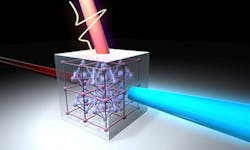Nonlinear optical crystal changes the color of laser light on the femtosecond time scale
Using femtosecond visible and terahertz pulses as external perturbations, scientists at the Tokyo Institute of Technology and the Institute for Integrated Cell-Material Sciences (iCems), Kyoto University have investigated the second harmonic generation (SHG) effect in photoexcited bismuth cobalt oxide (BiCoO3).1
This research highlights the importance of orbital excitation in the Co3+ ion, which in this research is driven by a pulse of terahertz radiation, and provides clues for improving the performance of nonlinear optical phenomena in nonlinear crystals on the femtosecond time scale.
Doubling the frequency of laser light (and thus changing its color) using SHG requires a polar crystal in which inversion symmetry is broken. For this reason, identifying crystals that can elicit strong SHG has been an important research topic, so that their properties can be exploited for applications in materials science.
Observation of nonlinear optical phenomena like SHG requires a finite second-order electric susceptibility, which occurs within any polar structure without inversion symmetry, and strong laser light or pulses. In the perovskite-type cobalt oxide BiCoO3 used in this work, an apical oxygen shift along the c-axis and a Co–O5 pyramid are present in the unit cell, resulting in symmetry breaking and a large spontaneous polarization at room temperature.
For the laser pulse, a strong electromagnetic pulse with an electric field up to about 1 MV/cm in the terahertz energy region was developed by Hideki Hirori and his team at iCems and was used to achieve ultrafast control of the nonlinear behavior of BiCoO3.
Yoichi Okimoto at the Tokyo Institute of Technology and colleagues were specifically interested in understanding how the intensity of SHG from the BiCoO3 crystal changes when irradiated with a terahertz laser pulse at room temperature. Notably, an unprecedented enhancement of SHG by more than 50% was observed, indicating that employing terahertz laser light in this fashion can significantly improve the figure of merit of nonlinear crystals. In addition, this effect occurs on the 100 fs time scale, suggesting possible application to ultrafast optoelectronic devices.
Future investigations of the photoexcited state of BiCoO3 and other polar oxide materials will consider higher-order nonlinear optical responses as well as ultrafast structural measurements using terahertz pulses to elucidate additional mechanistic details of these fascinating materials.
Source: http://www.titech.ac.jp/english/news/2017/038567.html
REFERENCE:
1. Y. Okimoto et al., Physical Review Applied (2017); 10.1103/PhysRevApplied.7.064016
About the Author
John Wallace
Senior Technical Editor (1998-2022)
John Wallace was with Laser Focus World for nearly 25 years, retiring in late June 2022. He obtained a bachelor's degree in mechanical engineering and physics at Rutgers University and a master's in optical engineering at the University of Rochester. Before becoming an editor, John worked as an engineer at RCA, Exxon, Eastman Kodak, and GCA Corporation.

